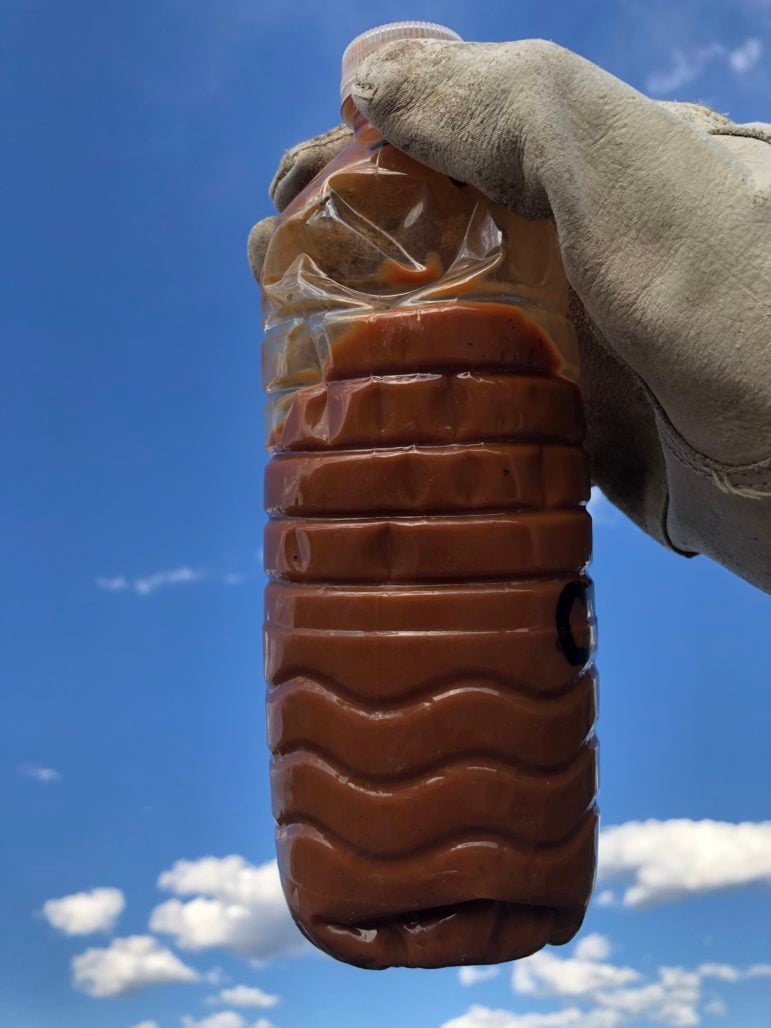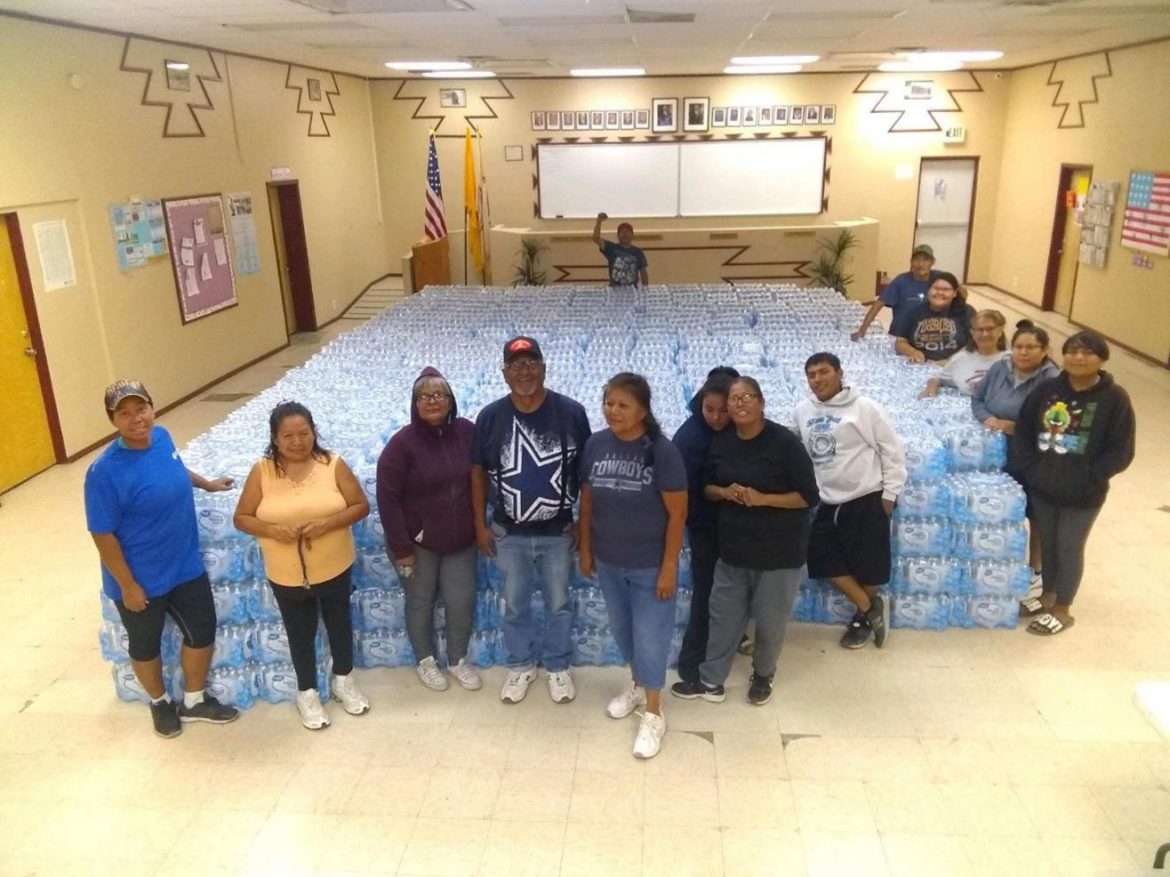Recent COVID-19-panic shopping stripped store shelves of bottled water, leaving the 2,000 residents of To’Hajiilee without drinking water. Over the years, five of the six wells supplying the satellite Navajo Nation community 20 miles west of Albuquerque have run dry, with the last generating mineral and sediment-steeped water that looks like orange juice and smells like rotten eggs.
“A lot of people don’t drink this water because it has bad taste, even when you make it with coffee,” said To’Hajiilee Chapter President Mark Begay.
When the stores ran short after the panic buying in mid-March, the Albuquerque Bernalillo County Water Authority began sending water tankers to the community, which lies within the boundaries of Bernalillo County. Residents drove to them to fill water jugs, buckets, and anything else they can, congregating while trying to maintain social distance, Begay said. This situation comes as the state of New Mexico has ordered people not to gather in groups of more than five and to regularly wash hands.
“It takes a lot of toll on our community members, not having safe, clean water to clean with,” Begay said.
Now the community is hoping to tap a possible new source of water — one it identified previously — but that has gained new urgency in the world of COVID-19.
When a developer completed a water tank 7.4 miles away, tribal leaders saw an opportunity to move off wells and onto the Albuquerque Bernalillo County Water Authority system, drawing water from the Rio Grande already allocated to the Navajo Nation. Tribal leaders have the money to lay water line to the tank and have identified a power line route to follow. But the route crosses private land. The community has approval of two of the three landowners but is trying to secure an easement from a third, Western Albuquerque Land Holdings (WALH).
Search for water
Getting that approval could solve a years-long search for a new water source.
The only well the community relies on stops working routinely and without notice, as happened last July. Taps just stop running. When they do, both the school and the health clinic must close.
Sediment in the water clogs the pumps and corrodes the pipes, causing the system to fail in a fraction of its expected lifespan. Ordering and installing a new pump takes days. Replacing parts every two years costs tens of thousands of dollars, Begay said, and “it’s like throwing money away.”

Twice in the last eight months, the community has needed emergency water tankers and bottled water brought in, which the water authority and state of New Mexico have donated.
“They’ve been able to access emergency points of contact to help, but to have to do that more than once a year is not a healthy situation,” said Cindy Browning, acting CEO and controller of CBN Health Center, Inc., which provides on-site health care for the community.
Since 2006, To’Hajiilee’s leadership has been searching for better options. George Mihalik, with the engineering firm Souder, Miller & Associates, first started communicating with them when To’Hajiilee wanted in on an effort to extract brine water from deep underground, desalinate it, and sell it as drinking water that was abandoned as financially infeasible. He’s continued working with the chapter on projects to improve water sources and delivery to homes.
“Drilling another well is not going to solve it,” Mihalik said. “The water quality and the water quantity is just not there.”
And drinking from the one remaining well isn’t recommended. Jim Platero, executive director of CBN Health Center, said people who do come to the health clinic sick to their stomachs. Used for laundry, the water from the well stains clothes.
Amid this pandemic, Platero said, health staff are encouraging the community to use some of the clean water they’ve gathered in jugs and buckets from the tankers the water authority has provided to wash their hands. Or he suggests buying hand sanitizer, if they can find it. So far, no one at the community has tested positive for COVID-19. Eighteen tests have been taken, with three still awaiting results as of Friday. But given the outbreaks in other parts of the Navajo Nation, there’s concern, and some have already discussed the possibility of converting the school into a quarantine site.

Moving forward
The proposed water line To’Hajiilee hopes to build would connect to a tank a developer paid to build as a condition of its permit and, as is standard, would be transferred to the Water Utility Authority. The tank holds 3 million gallons, Mihalik said, and the portion the tribe is asking to use would amount to 1 percent of its capacity.
“Things seem to be aligned — there’s infrastructure out there, and there’s now the potential to do something that wouldn’t be so outrageously expensive or difficult to do,” said Bernalillo County Commissioner Debbie O’Malley, who represents the district covering To’Hajiilee and vice-chairs the Albuquerque Bernalillo County Water Authority governing board. “We’ve pretty much tried everything, so now we’ve got to look at something that’s sustainable.”
After receiving approval to cross land from two property owners, the community is still seeking the easement for a two-mile section from Western Albuquerque Land Holdings, a subsidiary of Garrett Development Corporation, which is developing the proposed Santolina project. A large-scale development, it anticipates constructing roughly 38,000 households over the next 40 to 50 years, market conditions and demand depending. Garrett Development Corp. staff did not respond to interview requests.
The last correspondence from the developer requested a series of documents on water availability and serviceability from the Albuquerque Bernalillo County Water Authority, Begay said. Mihalik said he took those requests to the water authority and was told they didn’t apply to this situation.
“So far, it doesn’t seem like there’s a lot of willingness,” O’Malley said of efforts to secure that easement. “But you never know.”
County commissioners will be discussing an emergency water project for county residents including To’Hajiilee at a meeting Tuesday afternoon that is closed to the public because of attorney-client privileged communication around threatened or pending litigation. Given the pandemic, O’Malley said, “All these things coming together really make it a priority. … It certainly is a priority for me.”
Mihalik worries that without water, faced with this pandemic, the community is a ticking time bomb. Already, residents report a high incidence of underlying health problems, making many in To’Hajiilee vulnerable to the virus. The community also has living situations — he knows of one family where 12 people share a single two-bedroom, one-bath house — that could spread the virus if it gets into the population.
“That’ll be my happiest day, if we get this easement agreeable with both entities,” Begay said. “I really want to do this for our kids, you know, in the long run, so our young people, our kids that are coming up, they don’t have to worry about ever running out of water again.”
